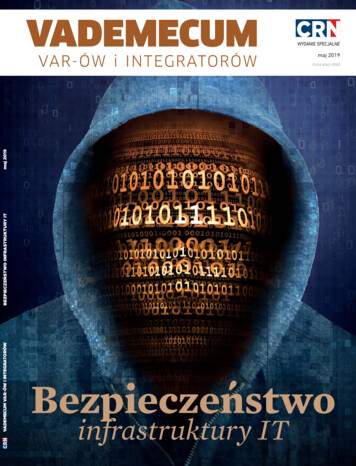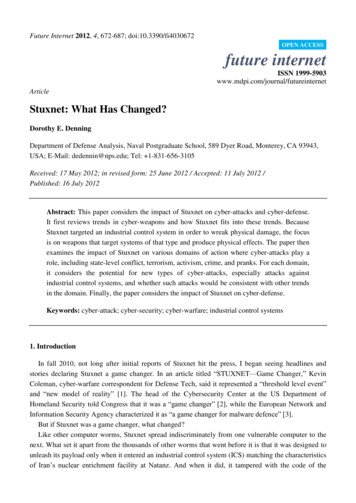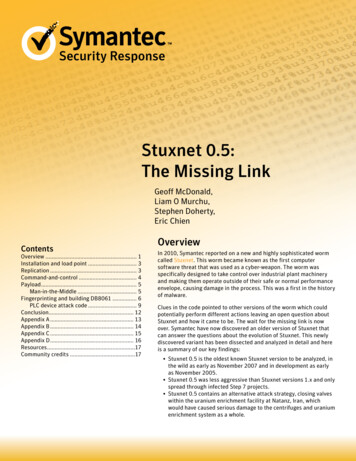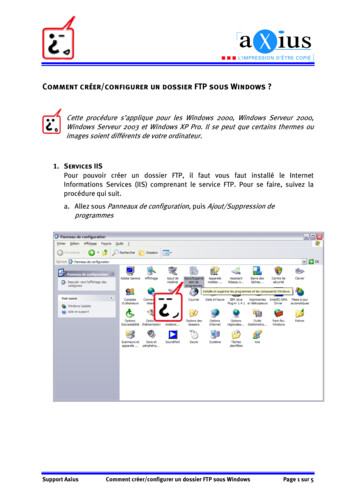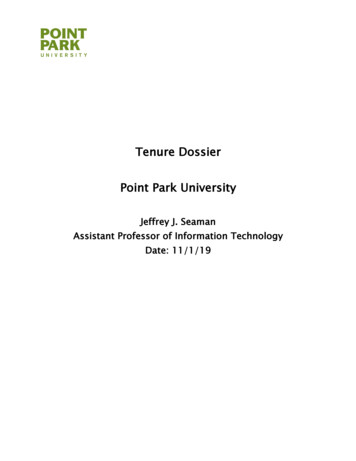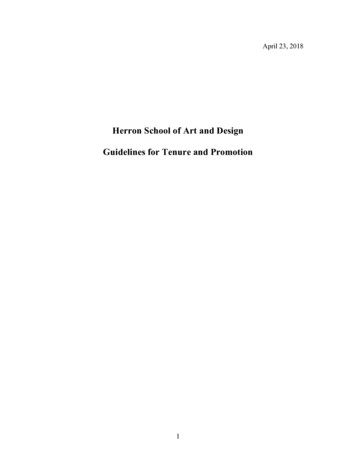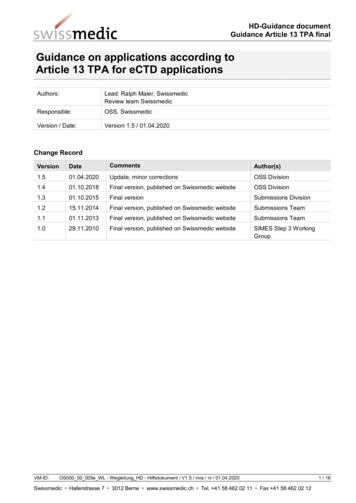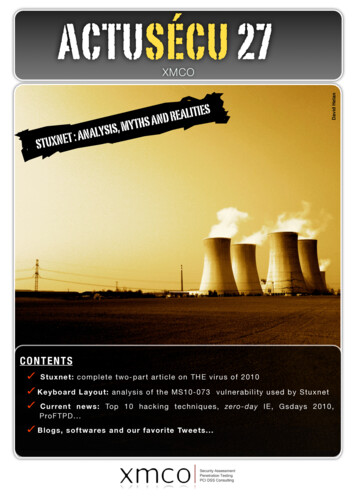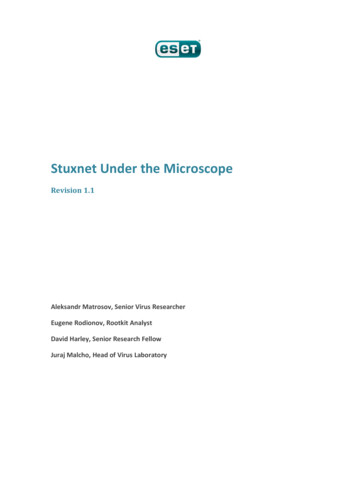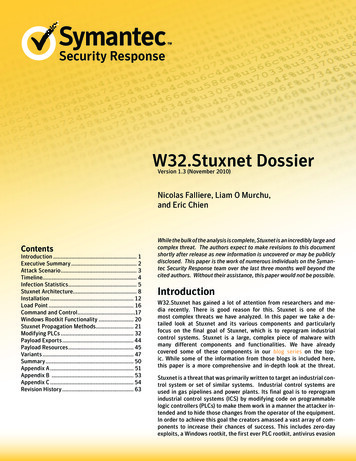
Transcription
Security ResponseW32.Stuxnet DossierVersion 1.3 (November 2010)Nicolas Falliere, Liam O Murchu,and Eric ChienContentsIntroduction. 1Executive Summary. 2Attack Scenario. 3Timeline. 4Infection Statistics. 5Stuxnet Architecture. 8Installation. 12Load Point. 16Command and Control.17Windows Rootkit Functionality. 20Stuxnet Propagation Methods. 21Modifying PLCs. 32Payload Exports. 44Payload Resources. 45Variants. 47Summary. 50Appendix A. 51Appendix B . 53Appendix C. 54Revision History. 63While the bulk of the analysis is complete, Stuxnet is an incredibly large andcomplex threat. The authors expect to make revisions to this documentshortly after release as new information is uncovered or may be publiclydisclosed. This paper is the work of numerous individuals on the Symantec Security Response team over the last three months well beyond thecited authors. Without their assistance, this paper would not be possible.IntroductionW32.Stuxnet has gained a lot of attention from researchers and media recently. There is good reason for this. Stuxnet is one of themost complex threats we have analyzed. In this paper we take a detailed look at Stuxnet and its various components and particularlyfocus on the final goal of Stuxnet, which is to reprogram industrialcontrol systems. Stuxnet is a large, complex piece of malware withmany different components and functionalities. We have alreadycovered some of these components in our blog series on the topic. While some of the information from those blogs is included here,this paper is a more comprehensive and in-depth look at the threat.Stuxnet is a threat that was primarily written to target an industrial control system or set of similar systems. Industrial control systems areused in gas pipelines and power plants. Its final goal is to reprogramindustrial control systems (ICS) by modifying code on programmablelogic controllers (PLCs) to make them work in a manner the attacker intended and to hide those changes from the operator of the equipment.In order to achieve this goal the creators amassed a vast array of components to increase their chances of success. This includes zero-dayexploits, a Windows rootkit, the first ever PLC rootkit, antivirus evasion
Security ResponseW32.Stuxnet Dossiertechniques, complex process injection and hooking code, network infection routines, peer-to-peer updates, anda command and control interface. We take a look at each of the different components of Stuxnet to understandhow the threat works in detail while keeping in mind that the ultimate goal of the threat is the most interestingand relevant part of the threat.Executive SummaryStuxnet is a threat targeting a specific industrial control system likely in Iran, such as a gas pipeline or powerplant. The ultimate goal of Stuxnet is to sabotage that facility by reprogramming programmable logic controllers(PLCs) to operate as the attackers intend them to, most likely out of their specified boundaries.Stuxnet was discovered in July, but is confirmed to have existed at least one year prior and likely even before.The majority of infections were found in Iran. Stuxnet contains many features such as: Self-replicates through removable drives exploiting a vulnerability allowing auto-execution.Microsoft Windows Shortcut ‘LNK/PIF’ Files Automatic File Execution Vulnerability (BID 41732) Spreads in a LAN through a vulnerability in the Windows Print Spooler.Microsoft Windows Print Spooler Service Remote Code Execution Vulnerability (BID 43073) Spreads through SMB by exploiting the Microsoft Windows Server Service RPC Handling Remote Code Execution Vulnerability (BID 31874). Copies and executes itself on remote computers through network shares. Copies and executes itself on remote computers running a WinCC database server. Copies itself into Step 7 projects in such a way that it automatically executes when the Step 7 project isloaded. Updates itself through a peer-to-peer mechanism within a LAN. Exploits a total of four unpatched Microsoft vulnerabilities, two of which are previously mentioned vulnerabilities for self-replication and the other two are escalation of privilege vulnerabilities that have yet to bedisclosed. Contacts a command and control server that allows the hacker to download and execute code, including updated versions. Contains a Windows rootkit that hide its binaries. Attempts to bypass security products. Fingerprints a specific industrial control system and modifies code on the Siemens PLCs to potentially sabotage the system. Hides modified code on PLCs, essentially a rootkit for PLCs.Page 2
Security ResponseW32.Stuxnet DossierAttack ScenarioThe following is a possible attack scenario. It is only speculation driven by the technical features of Stuxnet.Industrial control systems (ICS) are operated by a specialized assembly like code on programmable logic controllers (PLCs). The PLCs are often programmed from Windows computers not connected to the Internet or even theinternal network. In addition, the industrial control systems themselves are also unlikely to be connected to theInternet.First, the attackers needed to conduct reconnaissance. As each PLC is configured in a unique manner, the attackers would first need the ICS’s schematics. These design documents may have been stolen by an insider or evenretrieved by an early version of Stuxnet or other malicious binary. Once attackers had the design documents andpotential knowledge of the computing environment in the facility, they would develop the latest version of Stuxnet. Each feature of Stuxnet was implemented for a specific reason and for the final goal of potentially sabotaging the ICS.Attackers would need to setup a mirrored environment that would include the necessary ICS hardware, such asPLCs, modules, and peripherals in order to test their code. The full cycle may have taken six months and five toten core developers not counting numerous other individuals, such as quality assurance and management.In addition their malicious binaries contained driver files that needed to be digitally signed to avoid suspicion.The attackers compromised two digital certificates to achieve this task. The attackers would have needed toobtain the digital certificates from someone who may have physically entered the premises of the two companiesand stole them, as the two companies are in close physical proximity.To infect their target, Stuxnet would need to be introduced into the target environment. This may have occurredby infecting a willing or unknowing third party, such as a contractor who perhaps had access to the facility, or aninsider. The original infection may have been introduced by removable drive.Once Stuxnet had infected a computer within the organization it began to spread in search of Field PGs, whichare typical Windows computers but used to program PLCs. Since most of these computers are non-networked,Stuxnet would first try to spread to other computers on the LAN through a zero-day vulnerability, a two year oldvulnerability, infecting Step 7 projects, and through removable drives. Propagation through a LAN likely servedas the first step and propagation through removable drives as a means to cover the last and final hop to a FieldPG that is never connected to an untrusted network.While attackers could control Stuxnet with a command and control server, as mentioned previously the key computer was unlikely to have outbound Internet access. Thus, all the functionality required to sabotage a systemwas embedded directly in the Stuxnet executable. Updates to this executable would be propagated throughoutthe facility through a peer-to-peer method established by Stuxnet.When Stuxnet finally found a suitable computer, one that ran Step 7, it would then modify the code on the PLC.These modifications likely sabotaged the system, which was likely considered a high value target due to the largeresources invested in the creation of Stuxnet.Victims attempting to verify the issue would not see any rogue PLC code as Stuxnet hides its modifications.While their choice of using self-replication methods may have been necessary to ensure they’d find a suitableField PG, they also caused noticeable collateral damage by infecting machines outside the target organization.The attackers may have considered the collateral damage a necessity in order to effectively reach the intendedtarget. Also, the attackers likely completed their initial attack by the time they were discovered.Page 3
W32.Stuxnet DossierSecurity ResponseTimelineTable 1W32.Stuxnet TimelineDateEventNovember 20, 2008Trojan.Zlob variant found to be using the LNK vulnerability only later identified in Stuxnet.April, 2009Security magazine Hakin9 releases details of a remote code execution vulnerability in the Printer Spoolerservice. Later identified as MS10-061.June, 2009Earliest Stuxnet sample seen. Does not exploit MS10-046. Does not have signed driver files.January 25, 2010Stuxnet driver signed with a valid certificate belonging to Realtek Semiconductor Corps.March, 2010First Stuxnet variant to exploit MS10-046.June 17, 2010Virusblokada reports W32.Stuxnet (named RootkitTmphider). Reports that it’s using a vulnerability in theprocessing of shortcuts/.lnk files in order to propagate (later identified as MS10-046).July 13, 2010Symantec adds detection as W32.Temphid (previously detected as Trojan Horse).July 16, 2010Microsoft issues Security Advisory for “Vulnerability in Windows Shell Could Allow Remote Code Execution(2286198)” that covers the vulnerability in processing shortcuts/.lnk files.Verisign revokes Realtek Semiconductor Corps certificate.July 17, 2010Eset identifies a new Stuxnet driver, this time signed with a certificate from JMicron Technology Corp.July 19, 2010Siemens report that they are investigating reports of malware infecting Siemens WinCC SCADA systems.Symantec renames detection to W32.Stuxnet.July 20, 2010Symantec monitors the Stuxnet Command and Control traffic.July 22, 2010Verisign revokes the JMicron Technology Corps certificate.August 2, 2010Microsoft issues MS10-046, which patches the Windows Shell shortcut vulnerability.August 6, 2010Symantec reports how Stuxnet can inject and hide code on a PLC affecting industrial control systems.September 14, 2010Microsoft releases MS10-061 to patch the Printer Spooler Vulnerability identified by Symantec in August.Microsoft report two other privilege escalation vulnerabilities identified by Symantec in August.September 30, 2010Symantec presents at Virus Bulletin and releases comprehensive analysis of Stuxnet.Page 4
Security ResponseW32.Stuxnet DossierInfection StatisticsOn July 20, 2010 Symantec set up a system to monitor traffic to the Stuxnet command and control (C&C) servers. This allowed us to observe rates of infection and identify the locations of infected computers, ultimatelyworking with CERT and other organizations to help inform infected parties. The system only identified commandand control traffic from computers that were able to connect to the C&C servers. The data sent back to the C&Cservers is encrypted and includes data such as the internal and external IP address, computer name, OS version,and if it’s running the Siemens SIMATIC Step 7 industrial control software.As of September 29, 2010, the data has shown that there are approximately 100,000 infected hosts. The following graph shows the number of unique infected hosts by country:Figure 1Infected HostsThe following graph shows the number of infected organizations by country based on WAN IP addresses:Figure 2Infected Organizations (By WAN IP)Page 5
Security ResponseW32.Stuxnet DossierWe have observed over 40,000 unique external IP addresses, from over 155 countries. Looking at the percentageof infected hosts by country, shows that approximately 60% of infected hosts are in Iran:Figure 3Geographic Distribution of InfectionsStuxnet aims to identify those hosts which have the Siemens Step 7 software installed. The following chartshows the percentage of infected hosts by country with the Siemens software installed.Figure 4Percentage of Stuxnet infected Hosts with Siemens Software installedLooking at newly infected IP addresses per day, on August 22 we observed that Iran was no longer reporting newinfections. This was most likely due to Iran blocking outward connections to the command and control servers,rather than a drop-off in infections.Page 6
Security ResponseW32.Stuxnet DossierFigure 5Rate of Stuxnet infection of new IPs by CountryThe concentration of infections in Iran likely indicates that this was the initial target for infections and waswhere infections were initially seeded. While Stuxnet is a targeted threat, the use of a variety of propagationtechniques (which will be discussed later) has meant that Stuxnet has spread beyond the initial target. Theseadditional infections are likely to be “collateral damage”—unintentional side-effects of the promiscuous initialpropagation methodology utilized by Stuxent. While infection rates will likely drop as users patch their computers against the vulnerabilities used for propagation, worms of this nature typically continue to be able to propagate via unsecured and unpatched computers.Page 7
W32.Stuxnet DossierSecurity ResponseStuxnet ArchitectureOrganizationStuxnet has a complex architecture that is worth outlining before continuing with our analysis.The heart of Stuxnet consists of a large .dll file that contains many different exports and resources. In addition tothe large .dll file, Stuxnet also contains two encrypted configuration blocks.The dropper component of Stuxnet is a wrapper program that contains all of the above components stored insideitself in a section name “stub”. This stub section is integral to the working of Stuxnet. When the threat is executed, the wrapper extracts the .dll file from the stub section, maps it into memory as a module, and calls one of theexports.A pointer to the original stub section is passed to this export as a parameter. This export in turn will extract the.dll file from the stub section, which was passed as a parameter, map it into memory and call another differentexport from inside the mapped .dll file. The pointer to the original stub section is again passed as a parameter.This occurs continuously throughout the execution of the threat, so the original stub section is continuouslypassed around between different processes and functions as a parameter to the main payload. In this way everylayer of the threat always has access to the main .dll and the configuration blocks.In addition to loading the .dll file into memory and calling an export directly, Stuxnet also uses another techniqueto call exports from the main .dll file. This technique is to read an executable template from its own resources,populate the template withTable 2appropriate data, such asDLL Exportswhich .dll file to load andwhich export to call, and thenExport #Functionto inject this newly populated1Infect connected removable drives, starts RPC serverexecutable into another pro2Hooks APIs for Step 7 project file infectionscess and execute it. The newlypopulated executable tem4Calls the removal routine (export 18)plate will load the original .dll5Verifies if the threat is installed correctlyfile and call whatever export6Verifies version informationthe template was populated7Calls Export 6with.Although the threat usesthese two different techniques to call exports in themain .dll file, it should beclear that all the functionalityof the threat can be ascertained by analyzing all of theexports from the main .dll file.ExportsAs mentioned above, themain .dll file contains all ofthe code to control the worm.Each export from this .dllfile has a different purposein controlling the threat asoutlined in table 2.9Updates itself from infected Step 7 projects10Updates itself from infected Step 7 projects14Step 7 project file infection routine15Initial entry point16Main installation17Replaces Step 7 DLL18Uninstalls Stuxnet19Infects removable drives22Network propagation routines24Check Internet connection27RPC Server28Command and control routine29Command and control routine31Updates itself from infected Step 7 projects32Same as 1Page 8
W32.Stuxnet DossierSecurity ResponseResourcesThe main .dll file also contains many different resources that the exports above use in the course of controllingthe worm. The resources vary from full .dll files to template executables to configuration files and exploit modules.Both the exports and resources are discussed in the sections below.Table 3DLL ResourcesResource IDFunction201MrxNet.sys load driver, signed by Realtek202DLL for Step 7 infections203CAB file for WinCC infections205Data file for Resource 201207Autorun version of Stuxnet208Step 7 replacement DLL209Data file (%windows%\help\winmic.fts)210Template PE file used for injection221Exploits MS08-067 to spread via SMB.222Exploits MS10-061 Print Spooler Vulnerability231Internet connection check240LNK template file used to build LNK exploit241USB Loader DLL WTR4141.tmp242MRxnet.sys rootkit driver250Exploits Windows Win32k.sys Local Privilege Escalation (MS10-073)Bypassing Behavior Blocking When Loading DLLsWhenever Stuxnet needs to load a DLL, including itself, it uses a special method designed to bypass behaviorblocking and host intrusion-protection based technologies that monitor LoadLibrary calls. Stuxnet calls LoadLibrary with a specially crafted file name that does not exist on disk and normally causes LoadLibrary to fail.However, W32.Stuxnet has hooked Ntdll.dll to monitor for requests to load specially crafted file names. Thesespecially crafted filenames are mapped to another location instead—a location specified by W32.Stuxnet. Thatlocation is generally an area in memory where a .dll file has been decrypted and stored by the threat previously.The filenames used have the pattern of KERNEL32.DLL.ASLR.[HEXADECIMAL] or SHELL32.DLL.ASLR. [HEXADECIMAL], where the variable [HEXADECIMAL]is a hexadecimal value.The functions hooked for this purpose in Ntdll.dll are: FileZwQueryAttributesFileZwQuerySectionOnce a .dll file has been loaded via the method shown above, GetProcAddress is used to find the address of aspecific export from the .dll file and that export is called, handing control to that new .dll file.Page 9
W32.Stuxnet DossierSecurity ResponseInjection TechniqueWhenever an export is called, Stuxnet typically injects the entire DLL into another process and then just calls theparticular export. Stuxnet can inject into an existing or newly created arbitrary process or a preselected trustedprocess. When injecting into a trusted process, Stuxnet may keep the injected code in the trusted process orinstruct the trusted process to inject the code into another currently running process.The trusted process consists of a set of default Windows processes and a variety of security products. The currently running processes are enumerated for the following: Kaspersky KAV (avp.exe)Mcafee (Mcshield.exe)AntiVir (avguard.exe)BitDefender (bdagent.exe)Etrust (UmxCfg.exe)F-Secure (fsdfwd.exe)Symantec (rtvscan.exe)Symantec Common Client (ccSvcHst.exe)Eset NOD32 (ekrn.exe)Trend Pc-Cillin (tmpproxy.exe)In addition, the registry is searched for indicators that the following programs are installed: KAV v6 to v9 McAfee Trend PcCillinIf one of the above security product processes are detected, version information of the main image is extracted.Based on the version number, the target process of injection will be determined or the injection process will failif the threat considers the security product non-bypassable.The potential target processes for the injection are as follows: Lsass.exeWinlogon.exeSvchost.exeThe installed security product processTable 5 describes which process is used for injection depending on which security products are installed. In addition, Stuxnet will determine if it needs to use one of the two currently undisclosed privilege escalation vulnerabilities before injecting. Then, Stuxnet executes the target process in suspended mode.A template PE file is extracted from itself and a newsection called .verif is created. The section is madelarge enough so that the entry point address ofthe target process falls within the .verif section. Atthat address in the template PE file, Stuxnet placesa jump to the actual desired entry point of theinjected code. These bytes are then written to thetarget process and ResumeThread is called allowingthe process to execute and call the injected code.This technique may bypass security products thatemploy behavior-blocking.In addition to creating the new section and patching the entry point, the .stub section of the wrapper.dll file (that contains the main .dll file and configuration data) is mapped to the memory of the newprocess by means of shared sections. So the newTable 5Process InjectionSecurity Product Installed Injection targetKAV v1 to v7LSASS.EXEKAV v8 to v9KAV erLsass.exeETrust v5 to v6Fails to InjectETrust ESET NOD32Lsass.exeTrend PC CillinTrend ProcessPage 10
Security ResponseW32.Stuxnet Dossierprocess has access to the original .stub section. When the newly injected process is resumed, the injected codeunpacks the .dll file from the mapped .stub section and calls the desired export.Instead of executing the export directly, the injected code can also be instructed to inject into another arbitraryprocess instead and within that secondary process execute the desired export.Configuration Data BlockThe configuration data block contains all the values used to control how Stuxnet will act on a compromised computer. Example fields in the configuration data can be seen in the Appendix.When a new version of Stuxnet is created (using the main DLL plus the 90h-byte data block plus the configuration data), the configuration data is updated, and also a computer description block is appended to the block(encoded with a NOT XOR 0xFF). The computer description block contains information such as computer name,domain name, OS version, and infected S7P paths. Thus, the configuration data block can grow pretty big, largerthan the initial 744 bytes.The following is an example of the computer description block :5.1 - 1/1/0 - 2 - 2010/09/22-15:15:47 127.0.0.1, [c:\a\1.zip:\proj.s7p]The following describes each field:5.1 - Major OS Version and Minor OS Version1/1/0 – Flags used by Stuxnet2 – Flag specifying if the computer is part of a workgroup or domain2010/09/22-15:15:47 – Time of infection127.0.0.1 – IP address of the compromised computer[c:\a\1.zip:\proj.s7p] – file name of infected project filePage 11
Security ResponseW32.Stuxnet DossierInstallationExport 15 is the first export called when the .dll file is loaded for the first time. It is responsible for checking thatthe threat is running on a compatible version of Windows, checking whether the computer is already infected ornot, elevating the privilege of the current process to system, checking what antivirus products are installed, andwhat the best process to inject into is. It then injects the .dll file into the chosen process using a unique injectiontechnique described in the Injection Technique section and calls export 16.Figure 6Control flow for export 15The first task in export 15 is to check if the configuration data is up-to-date. The configuration data can bestored in two locations. Stuxnet checks which is most up-to-date and proceeds with that configuration data.Next, Stuxnet determines if it is running on a 64-bit machine or not; if the machine is 64-bit the threat exits.At this point it also checks to see what operating system it is running on. Stuxnet will only run on the followingoperating systems: Win2KWinXPWindows 2003VistaWindows Server 2008Windows 7Windows Server 2008 R2If it is not running on one of these operating systems it will exit.Next, Stuxnet checks if it has Administrator rights on the computer. Stuxnet wants to run with the highest privilege possible so that it will have permission to take whatever actions it likes on the computer. If it does not haveAdministrator rights, it will execute one of the two zero-day escalation of privilege attacks described below.Page 12
Security ResponseW32.Stuxnet DossierIf the process already has the rights it requires it proceeds to prepare to call export 16 in the main .dll file. It callsexport 16 by using the injection techniques described in the Injection Technique section.When the process does not have Adminstrator rights on the system it will try to attain these privileges by usingone of two zero-day escalation of privilege attacks. The attack vector used is based on the operating systemof the compromised computer. If the operating system is Windows Vista, Windows 7, or Windows Server 2008R2 the currently undisclosed Task Scheduler Escalation of Privilege vulnerability is exploited. If the operatingsystem is Windows XP or Windows 2000 the Windows Win32k.sys Local Privilege Escalation vulnerability (MS10073) is exploited.If exploited, both of these vulnerabilities result in the main .dll file running as a new process, either within thecsrss.exe process in the case of the win32k.sys vulnerability or as a new task with Adminstrator rights in thecase of the Task Scheduler vulnerability.The code to exploit the win32k.sys vulnerability is stored in resource 250. Details of the Task Scheduler vulnerability currently are not released as patches are not yet available. The Win32k.sys vulnerability is described inthe Windows Win32k.sys Local Privilege Escalation vulnerability (MS10-073) section.After export 15 completes the required checks, export 16 is called.Export 16 is the main installer for Stuxnet. It checks the date and the version number of the compromised computer; decrypts, creates and installs the rootkit files and registry keys; injects itself into the services.exe processto infect removable drives; injects itself into the Step7 process to infect all Step 7 projects; sets up the globalmutexes that are used to communicate between different components; and connects to the RPC server.Figure 7Infection routine flowExport 16 first checks that the configuration data is valid, after that it checks the value “NTVDM TRACE” in thefollowing registry key:HKEY LOCAL MS-DOS EmulationPage 13
Security ResponseW32.Stuxnet DossierIf this value is equal to 19790509 the threat will exit. This is thought to be an infection marker or a “do notinfect” marker. If this is set correctly infection will not occur. The value may be a random string and representnothing, but also appears to match the format of date markers used in the threat. As a date, the value may beMay 9, 1979. This date could be an arbitrary date, a birth date, or some other significant date. While on May 9,1979 a variety of historical events occured, according to Wikipedia “Habib Elghanian was executed by a firingsquad in Tehran sending shock waves through the closely knit Iranian Jewish community. He was the first Jewand one of the first civilians to be executed by the new Islamic government. This prompted the mass exodus ofthe once 100,000 member strong Jewish community of Iran which continues to this day.” Symantec cautionsreaders on drawing any attribution conclusions. Attackers would have the natural desire to implicate anotherparty.Next, Stuxnet reads a date from the configuration data (offset 0x8c in the configuration data). If the current dateis later than the date in the configuration file then infection will also not occur and the threat will exit. The datefound in the current configuration file is June 24, 2012.Stuxnet communicates between different components via global mutexes. Stuxnet tries to create such a globalmutex but first it will use SetSecurityDescriptorDacl for computers running Windows XP and also the SetSecurityDescriptorSacl API for computers running Windows Vista or later to reduce the integrity levels of objects, andthus ensure no write actions are denied.Next, Stuxnet creates 3 encrypted files. These files are read from the .stub section of Stuxnet; encrypted andwritten to disk, the files are:1. The main Stuxnet payload .dll file is saved as Oem7a.pnf2. A 90 byte data file copied to %SystemDrive%\inf\mdmeric3.PNF3. The configuration data for Stuxnet is copied to %SystemDrive%\inf\mdmcpq3.PNF4. A log file is copied to %SystemDrive%\inf\oem6C.PNFThen Stuxnet checks the date again to ensure the current date is before June 24, 2012.Subsequently Stuxnet checks whether it is the latest version or if the version encrypted on disk is newer. It doesthis by reading the encrypted version from the disk, decrypting it, and loading it into memory. Once loaded Stuxnet calls export 6 from the newly loaded file; export 6 returns the version n
W32.Stuxnet Dossier Page 2 Security Response techniques, complex process injection and hooking code, network infection routines, peer-to-peer updates, and
